人教版(2019) 必修第一册 Unit 2 Travelling Around Integrated skills 第2课时 课件-(18张ppt)
文档属性
| 名称 | 人教版(2019) 必修第一册 Unit 2 Travelling Around Integrated skills 第2课时 课件-(18张ppt) | 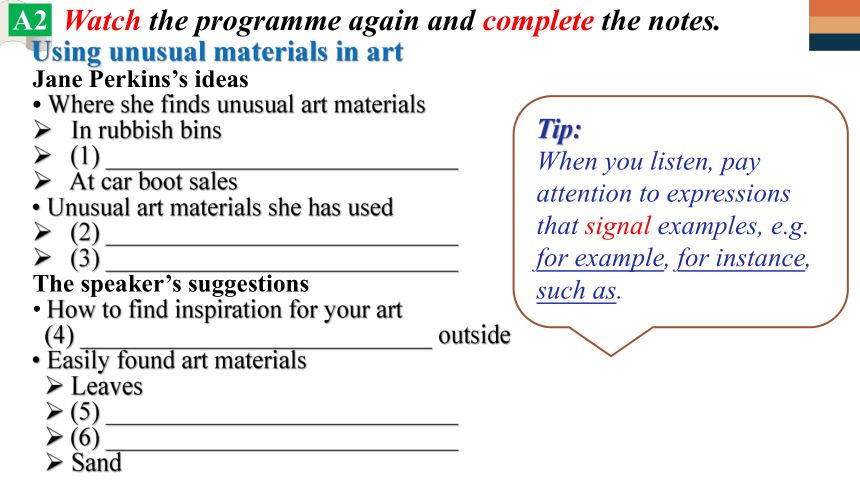 | |
| 格式 | pptx | ||
| 文件大小 | 124.6MB | ||
| 资源类型 | 教案 | ||
| 版本资源 | 人教版(2019) | ||
| 科目 | 英语 | ||
| 更新时间 | 2022-10-20 10:00:42 | ||
图片预览

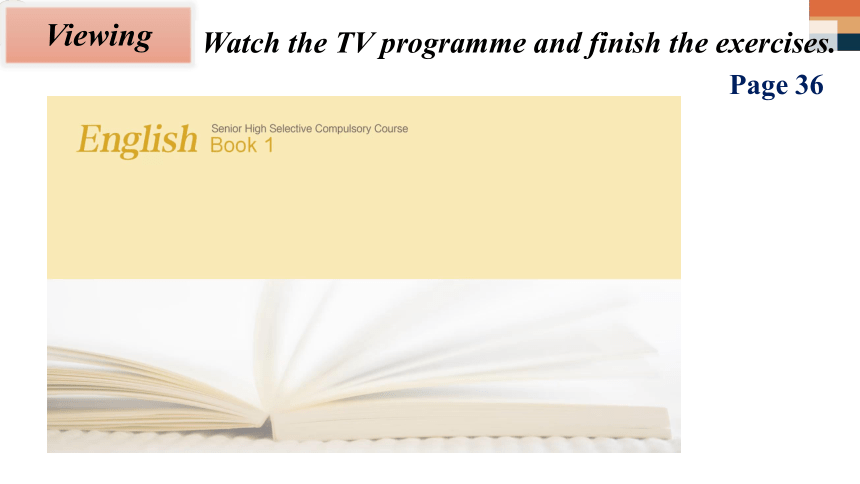
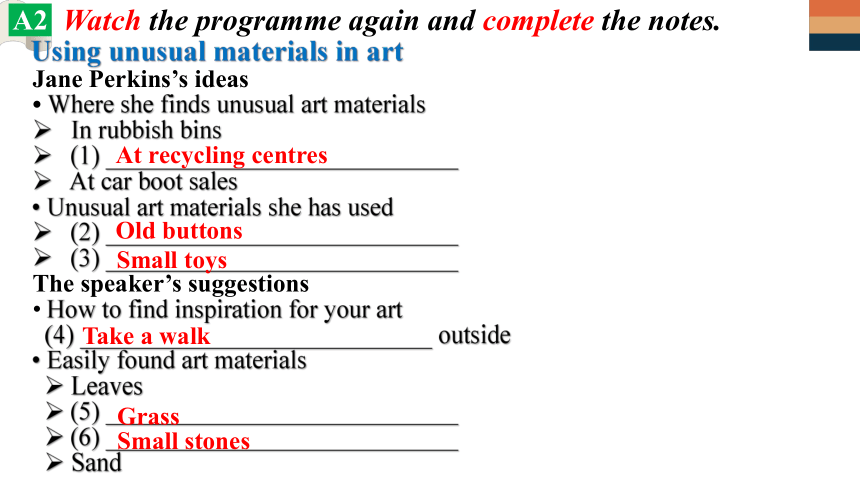
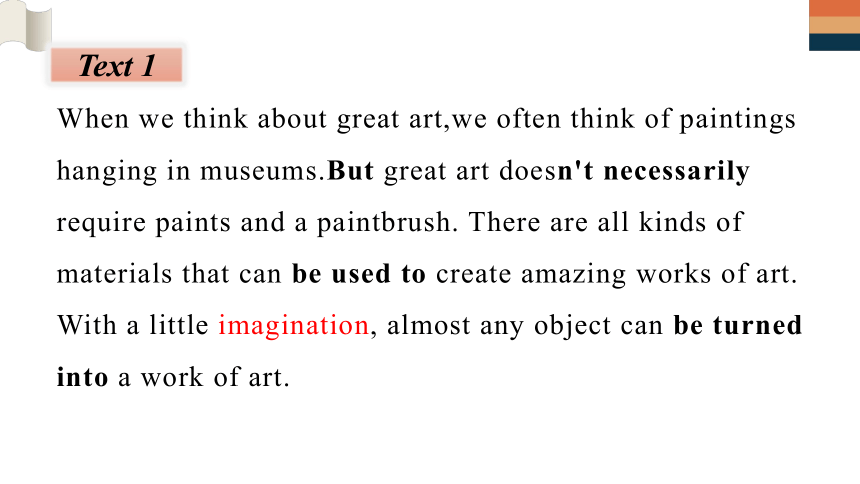
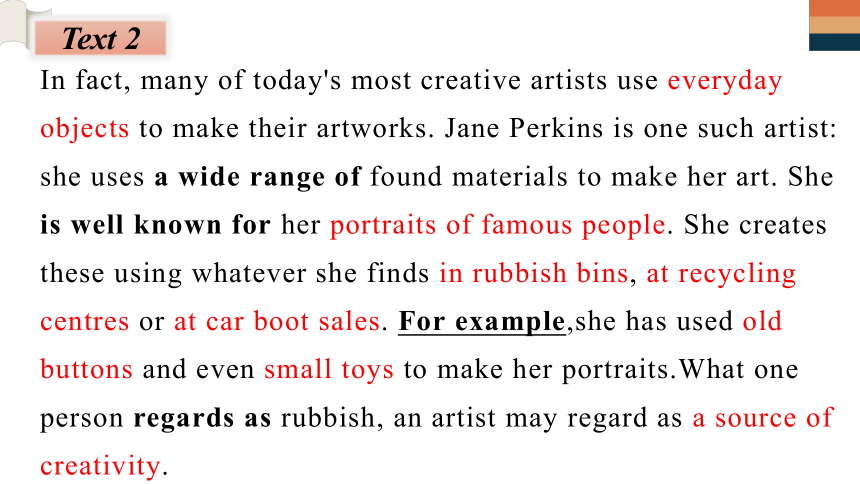
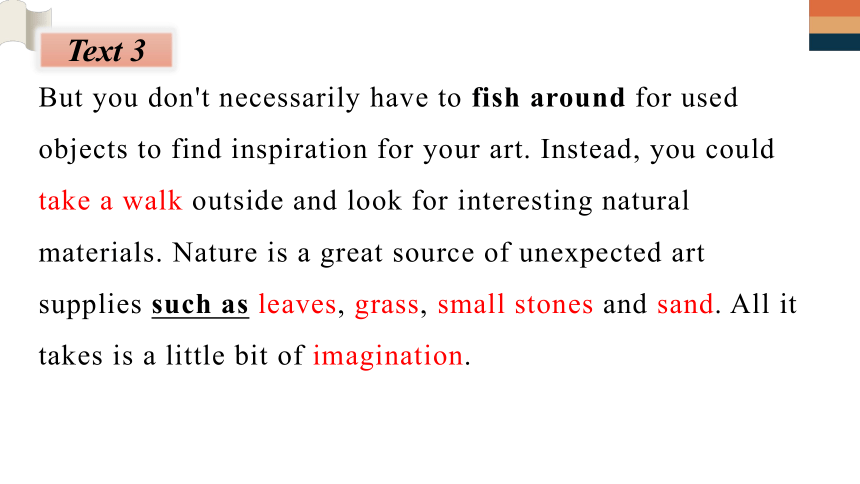
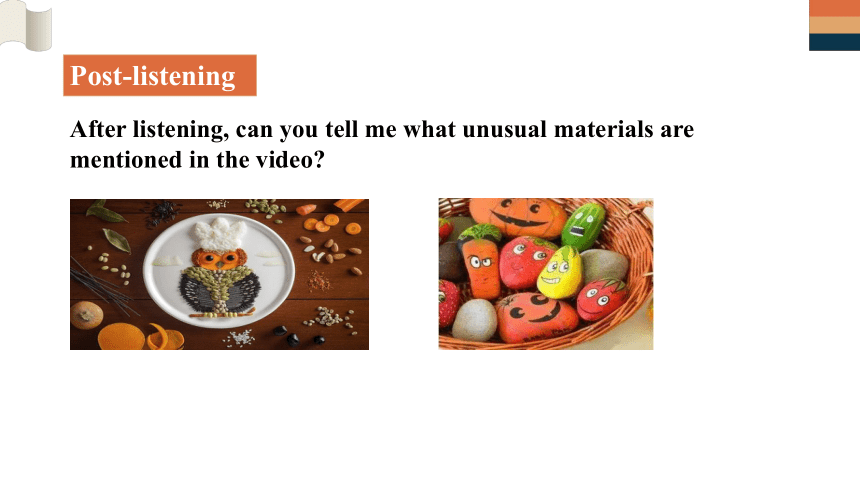
文档简介
(共18张PPT)
Jane Perkins’s ideas
Where she finds unusual art materials
In rubbish bins
(1) ____________________________
At car boot sales
Unusual art materials she has used
(2) ____________________________
(3) ____________________________
The speaker’s suggestions
How to find inspiration for your art
(4) ____________________________ outside
Easily found art materials
Leaves
(5) ____________________________
(6) ____________________________
Sand
Watch the programme again and complete the notes.
Using unusual materials in art
A2
Tip:
When you listen, pay attention to expressions that signal examples, e.g. for example, for instance, such as.
Viewing
Watch the TV programme and finish the exercises.
Page 36
Jane Perkins’s ideas
Where she finds unusual art materials
In rubbish bins
(1) ____________________________
At car boot sales
Unusual art materials she has used
(2) ____________________________
(3) ____________________________
The speaker’s suggestions
How to find inspiration for your art
(4) ____________________________ outside
Easily found art materials
Leaves
(5) ____________________________
(6) ____________________________
Sand
Watch the programme again and complete the notes.
Using unusual materials in art
At recycling centres
Old buttons
Small toys
Take a walk
Grass
Small stones
A2
When we think about great art,we often think of paintings hanging in museums.But great art doesn't necessarily require paints and a paintbrush. There are all kinds of materials that can be used to create amazing works of art. With a little imagination, almost any object can be turned into a work of art.
Text 1
In fact, many of today's most creative artists use everyday objects to make their artworks. Jane Perkins is one such artist: she uses a wide range of found materials to make her art. She is well known for her portraits of famous people. She creates these using whatever she finds in rubbish bins, at recycling centres or at car boot sales. For example,she has used old buttons and even small toys to make her portraits.What one person regards as rubbish, an artist may regard as a source of creativity.
Text 2
But you don't necessarily have to fish around for used objects to find inspiration for your art. Instead, you could take a walk outside and look for interesting natural materials. Nature is a great source of unexpected art supplies such as leaves, grass, small stones and sand. All it takes is a little bit of imagination.
Text 3
Post-listening
After listening, can you tell me what unusual materials are mentioned in the video
Unusual art materials
Materials mentioned in the video
More materials
Old buttons
Small toys
Grass
Small stones
Leaves
Sand
old clothes
plastic bottles
old batteries
old shoes
...
Can you make an unusual picture with unusual materials
Reading to write:
Lisa wants to create art using unusual materials and she has found some instructions for making unusual pictures. Read the instructions and pay attention to the structure.
How to make an amazing food portrait
·We need a large piece of toast, a variety of vegetables and a knife.
· step 1 : lay your toast on the table.
· step 2: cut the vegetable to create different parts of the face. For example, red peppers can be used to make the mouth. Slices of garlic can be used to create teeth. Mushrooms can be used for eyes
· step 3: arrange the vegetables on the toast to create your portrait.
Arrange the vegetables on the toast to create your portrait.
Several food portraits made out of food.
Making a seashell picture
·Seashells come in many varieties, so there are endless possibilities for the kinds of picture you can create.
· step 1 : collect seashells
· step 2: decide what image you want to create and select seashells of different shapes and sizes
· step 3: arrange your seashells on the cardboard.
· step 4: stick each seashell to the cardboard using glue.
What image will you create
Start with a brief introduction explaining what kind of unusual picture will be created.
What materials and tools will you use for your picture
List the things needed to make the picture. You can use a heading like “What you need”, “Things you need” or “materials and tools”.
What steps will you take to create the picture
Give well-organized directions under the heading of “What to do” , “Procedures” or “directions”.
Planning your writing
Let’s work in groups.
Design the image that you want to create;
Collect the materials that you need;
Arrange the materials and turn them into an unusual picture;
Write down the instructions for making it.
Jane Perkins’s ideas
Where she finds unusual art materials
In rubbish bins
(1) ____________________________
At car boot sales
Unusual art materials she has used
(2) ____________________________
(3) ____________________________
The speaker’s suggestions
How to find inspiration for your art
(4) ____________________________ outside
Easily found art materials
Leaves
(5) ____________________________
(6) ____________________________
Sand
Watch the programme again and complete the notes.
Using unusual materials in art
A2
Tip:
When you listen, pay attention to expressions that signal examples, e.g. for example, for instance, such as.
Viewing
Watch the TV programme and finish the exercises.
Page 36
Jane Perkins’s ideas
Where she finds unusual art materials
In rubbish bins
(1) ____________________________
At car boot sales
Unusual art materials she has used
(2) ____________________________
(3) ____________________________
The speaker’s suggestions
How to find inspiration for your art
(4) ____________________________ outside
Easily found art materials
Leaves
(5) ____________________________
(6) ____________________________
Sand
Watch the programme again and complete the notes.
Using unusual materials in art
At recycling centres
Old buttons
Small toys
Take a walk
Grass
Small stones
A2
When we think about great art,we often think of paintings hanging in museums.But great art doesn't necessarily require paints and a paintbrush. There are all kinds of materials that can be used to create amazing works of art. With a little imagination, almost any object can be turned into a work of art.
Text 1
In fact, many of today's most creative artists use everyday objects to make their artworks. Jane Perkins is one such artist: she uses a wide range of found materials to make her art. She is well known for her portraits of famous people. She creates these using whatever she finds in rubbish bins, at recycling centres or at car boot sales. For example,she has used old buttons and even small toys to make her portraits.What one person regards as rubbish, an artist may regard as a source of creativity.
Text 2
But you don't necessarily have to fish around for used objects to find inspiration for your art. Instead, you could take a walk outside and look for interesting natural materials. Nature is a great source of unexpected art supplies such as leaves, grass, small stones and sand. All it takes is a little bit of imagination.
Text 3
Post-listening
After listening, can you tell me what unusual materials are mentioned in the video
Unusual art materials
Materials mentioned in the video
More materials
Old buttons
Small toys
Grass
Small stones
Leaves
Sand
old clothes
plastic bottles
old batteries
old shoes
...
Can you make an unusual picture with unusual materials
Reading to write:
Lisa wants to create art using unusual materials and she has found some instructions for making unusual pictures. Read the instructions and pay attention to the structure.
How to make an amazing food portrait
·We need a large piece of toast, a variety of vegetables and a knife.
· step 1 : lay your toast on the table.
· step 2: cut the vegetable to create different parts of the face. For example, red peppers can be used to make the mouth. Slices of garlic can be used to create teeth. Mushrooms can be used for eyes
· step 3: arrange the vegetables on the toast to create your portrait.
Arrange the vegetables on the toast to create your portrait.
Several food portraits made out of food.
Making a seashell picture
·Seashells come in many varieties, so there are endless possibilities for the kinds of picture you can create.
· step 1 : collect seashells
· step 2: decide what image you want to create and select seashells of different shapes and sizes
· step 3: arrange your seashells on the cardboard.
· step 4: stick each seashell to the cardboard using glue.
What image will you create
Start with a brief introduction explaining what kind of unusual picture will be created.
What materials and tools will you use for your picture
List the things needed to make the picture. You can use a heading like “What you need”, “Things you need” or “materials and tools”.
What steps will you take to create the picture
Give well-organized directions under the heading of “What to do” , “Procedures” or “directions”.
Planning your writing
Let’s work in groups.
Design the image that you want to create;
Collect the materials that you need;
Arrange the materials and turn them into an unusual picture;
Write down the instructions for making it.
